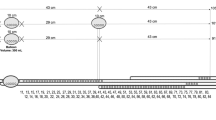Abstract
An endoscopic manometric technique was applied to the study of intraductal biliary and pancreatic pressures and sphincter activity in normal subjects. A perfused system using a modified endoscopic retrograde cholangiopancreatography catheter was tested and found to provide reliable ductal and phasic recordings. Twenty-five healthy volunteers aged 19–37, underwent endoscopic manometry under diazepam sedation. Distinct zones of high-pressure phasic activity were identified on pull-through from the pancreatic duct and common bile duct at mean distances of 4.5 and 5.0 mm, respectively, from the papillary orifice with frequencies of 7.0±1.8 (mean±sd) and 5.6±2.4 waves/min, respectively. These were considered to represent separate pancreatic duct and bile duct sphincters. Peak pancreatic duct sphincter pressure (47.6±8.2 mm Hg) and bile duct sphincter pressure (57.2±10.7 mm Hg) were similar. Pancreatic duct pressure was 11.4±3.0. mm Hg and common bile duct pressure was 3.0±2.5 mm Hg. Values were adjusted to duodenal pressure as zero reference. The ductal and sphincteric pressures reported in this study provide a basis for the assessment of physiological, pharmacological, pathophysiological, and surgical effects on this area.
Similar content being viewed by others
References
Boyden EA: The pars intestinalis of the common bile duct, as viewed by the older anatomists (Vesalius, Glisson, Bianchi, Vater, Haller, Santorini, etc). Anat Rec 66:217–232, 1936
Gage SH: The ampulla of Vater and the pancreatic ducts in the domestic cat (Felis domestica). Am Q Microsc J 1:128–169, 1879
Oddi R: D'une disposition a sphincter speciale de l'ouverture due canal choledoque. Arch Ital Biol 8:317–322, 1887
Long H: Observations on the choledocho-duodenal mechanism and their bearing on the physiology and pathology of the biliary tract. Br J Surg 29:422–437, 1942
Hendrickson WF: A study of the musculature of the entire extrahepatic biliary system, including that of the duodenal portion of the common bile duct and of the sphincter. Bull Johns Hopkins Hosp 9:212–232, 1898
Boyden EA: The sphincter of Oddi in man and certain representative mammals. Surgery 1:25–37, 1937
Bergh GS, Layne JA: A demonstration of the independent contraction of the sphincter of the independent contraction of the sphincter of the common bile duct in human subjects. Am J Physiol 128:690–694, 1940
Ivy AC: Motor dysfunction of the biliary tract. Am J Roentgenol Rad Ther 57:1–11, 1947
Didio LJA, Anderson MC: The “Sphincters” of the Digestive System. Anatomical, Functional and Surgical Considerations. Baltimore, Williams and Wilkins, 1968, pp 128–151
Delmont J: An attempt to collate. The sphincter of Oddi, Proceedings of the 3rd Gastrointestinal Symposium, Nice, 1976. Basel, Karger, 1977, pp 240–255
Gregg JA: Endoscopic cannulation of the ampulla of Vater. Am J Gastroenterol 60:142–156, 1973
Cotton PB: Cannulation of the papilla of Vater by endoscopy and retrograde cholangiopancreatography (ERCP). Gut 13:1014–1025, 1972
Nebel OT: Manometric evaluation of the papilla of Vater. Gastrointest Endosc 21:126–128, 1975
Nebel OT: Effect of enteric hormones on the human sphincter of Oddi. Gastroenterology 68:A105/962, 1975
Bradley VD, Nebel OT: Clinical evaluation of sphincter of Oddi in man. Gastrointest Endosc 24:27–29, 1977
Rosch W, Koch H, Demling L: Manometric studies during endoscopic retrograde cholangiopancreatography and endoscopic papillotomy. Endoscopy 8:30–33, 1976
Hagenmuller F, Ossenberg FW, Classen M: Duodenoscopic manometry of the common bile duct. The sphincter of Oddi. Proceedings of the 3rd Gastrointestinal Symposium, Nice, 1976, Basel, Karger, 1977, pp 72–76
Geenen JE, Hogan WJ, Shaffer RD, Stewart ET, Dodds WJ, Arndorfer RC: Endoscopic electrosurgical papillotomy and manometry in biliary tract disease. J Am Med Assoc 237:2075–2078, 1977
Geenen JE, Stewart ET: Endoscopic papillotomy.In Atlas of Endoscopic Retrograde Cholangiopancreatography, ET Stewart, J Vennes, JE Geenen (eds). St. Louis, CV Mosby, 1977, pp 334–336
Rosch W, Lux G, Seuberth K: A new catheter for endoscopic manometry of Oddi's sphincter. Endoscopy 9:31–33, 1977
Hogan WJ, Dodds WJ, Geenen JE, Shaffer RD, Stewart ET, Andorfer RC: Sphincter of Oddi motor activity in man: A zone of unique, phasic high-pressure contractions.In Gastrointestinal Motility in Health and Disease. Proceedings 6th International Symposium on Gastrointestinal Motility, Edinburgh, 1977, HL Duthie (ed). Baltimore, University Park Press, 1977, pp 593–594
Funch-Jensen P, Csendes A, Kruse A, Oster MJ: Common bile duct pressure and Oddi sphincter pressure in patients with common bile duct stones with and without juxta-ampullar diverticula of the duodenum. Scand J Gastroenterol 14:253–256, 1979
Bar-Meir S, Geenen JE, Hogan WJ, Dodds WJ, Stewart ET, Arndorfer RC: Biliary and pancreatic duct pressures measured by ERCP manometry in patients with suspected papillary stenosis. Dig Dis Sci 24:209–213, 1979
Boulter PS: The effects of analgesics and anti-spasmodics on flow through the human bile duct. Guy's Hosp Rep 110:246–262, 1961
Hopton DS, Torrance HB: Action of various new analgesic drugs on the human common bile duct. Gut 8:296–300, 1967
Economu G, Warde-McQuaid JN: A cross-over comparison of the effect of morphine, pethidine, pentazocine, and phenazocine on biliary pressure. Gut 12:218–221, 1971
Du Val MK Jr: The effect of chronic pancreatitis on pressure tolerance in the human pancreatic duct. Surgery 43:798–801, 1958
Anderson MC, Hagstrom WJL: A comparison of pancreatic and biliary pressures recorded simultaneously in man. Can J Surg 5:461–470, 1962
Carr-Locke DL, Gregg JA: Endoscopic manometry of biliary and pancreatic sphincters: Findings in biliary and pancreatic disease and after sphincter surgery. Am J Gastroenterol 72:333, 1979
Author information
Authors and Affiliations
Additional information
This work was supported by grants from the Katherine Gavriluk and Sara Jordan Funds, New England Baptist Hospital, Boston, Massachusetts, and Dr. Carr-Locke is in receipt of grants from the Wellcome Research Travel Fund, London, England, the Leicester Area Health Authority, Leicester, England, and the P and C Hickinbotham Trust, Leicester, England.
Rights and permissions
About this article
Cite this article
Carr-Locke, D.L., Gregg, J.A. Endoscopic manometry of pancreatic and biliary sphincter zones in man. Digest Dis Sci 26, 7–15 (1981). https://doi.org/10.1007/BF01307970
Received:
Revised:
Accepted:
Issue Date:
DOI: https://doi.org/10.1007/BF01307970




